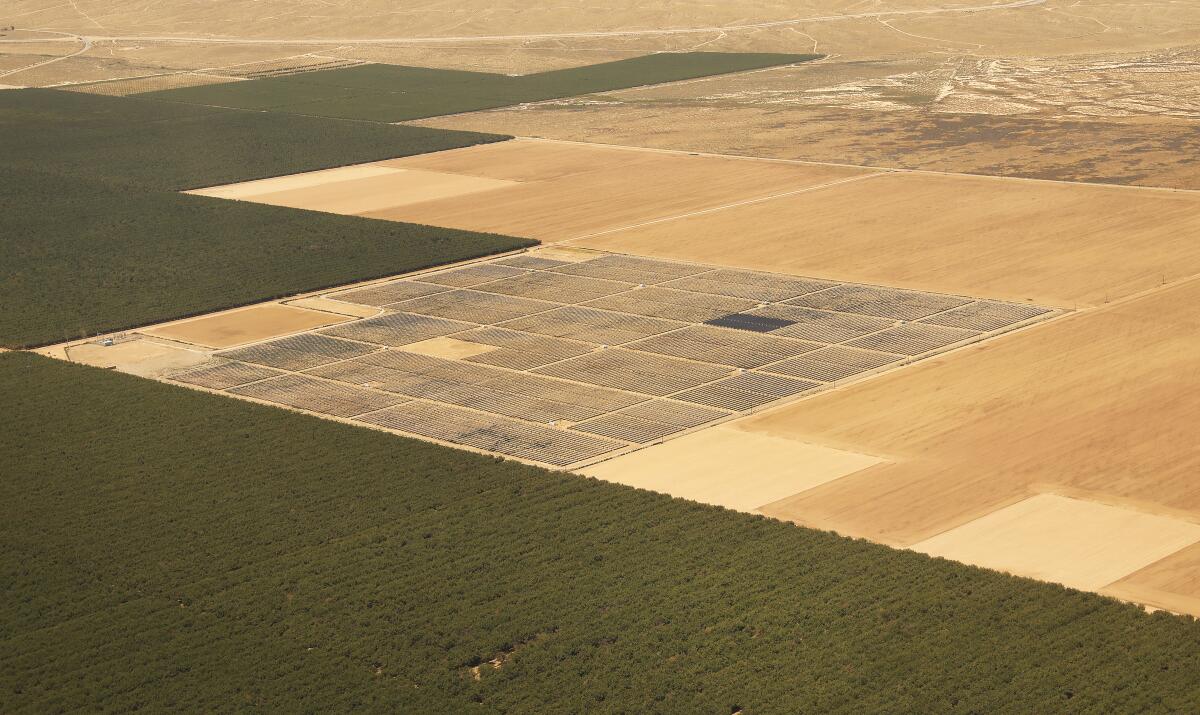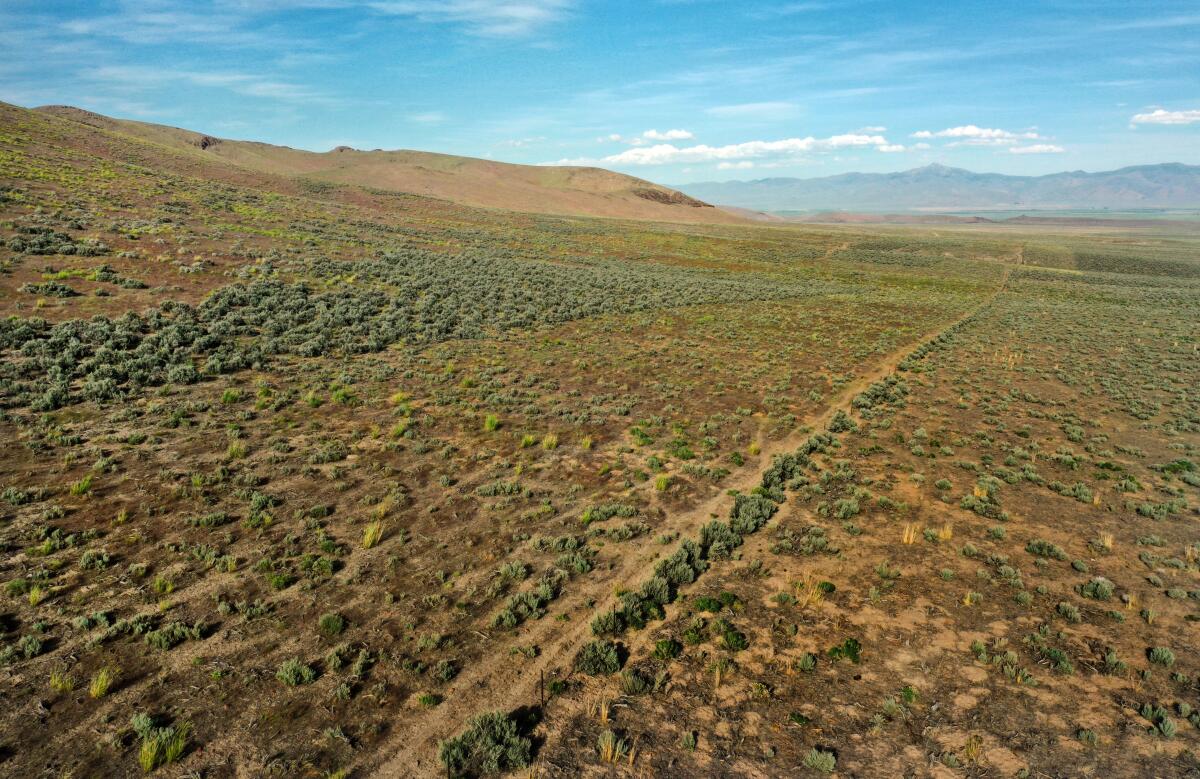If you don’t love burrowing owls, you’ve probably never seen a burrowing owl.
They’re 7 to 10 inches tall, with bright yellow eyes and long, skinny legs. The western variety doesn’t even dig its own underground burrows. It depends on other critters, such as ground squirrels and desert tortoises.
Here’s a picture:
A burrowing owl keeps watch in a busy park in California’s Contra Costa County.
(Lauren Bettino)
Building solar projects in spots where burrowing owls are struggling to survive would be a terrible idea, right?
I’ve said it before, I’ll say it again: If only the world were so simple.
Newsletter
You’re reading Boiling Point
Sammy Roth gets you up to speed on climate change, energy and the environment. Sign up to get it in your inbox twice a week.
You may occasionally receive promotional content from the Los Angeles Times.
As my L.A. Times colleague Lila Seidman reports, the California Fish and Game Commission voted unanimously last week to make the bird a candidate for protection under the state’s Endangered Species Act. In practice, that means burrowing owls will be protected under the law for the next 12 to 18 months, while state wildlife officials study whether the adorable bird deserves permanent status as a “threatened” or “endangered” species.
Two decades ago, there were as many as 10,500 breeding pairs of burrowing owls in the Golden State, according to the California Department of Fish and Wildlife. Now there are just 6,500 pairs, the department estimates.
Suburban sprawl was the biggest culprit, conservation groups say, with residential and commercial development tearing up owl habitat across the state and giving the funky little birds precious little space to nest and breed.
But other industries contributed to habitat fragmentation and destruction too — including renewable energy.
Not many wind farms are being built in California these days, at least on the shore; the windiest spots have long been taken. But lots of massive solar farms are being planned and built to replace planet-wrecking fossil fuels.
Conservation activists want state officials to impose new requirements on energy companies looking to build in burrowing owl habitat — requiring them to pay for the permanent protection of breeding grounds, for instance. Activists also hope state officials will block construction of solar projects in the best spots for burrowing owls.
“We can have abundant burrowing owls and abundant solar development,” said Jeff Miller, a senior conservation advocate at the Center for Biological Diversity. “I don’t think the [protections] will slow solar development.”
I hope he’s right. But I’m a little anxious.
It’s not just burrowing owl advocates who are concerned about the the consequences of solar sprawl. It’s desert tortoise advocates and Joshua tree advocates. It’s rural residents who don’t want solar in the backyards, and farmers who don’t want solar projects taking away cropland — even when they don’t have enough water for all their crops.

A solar project is surrounded by farmland in the San Joaquin Valley.
(Al Seib / Los Angeles Times)
If only we could put all the solar panels we need to replace fossil fuels on rooftops, warehouses and parking lots, this problem would be easy to solve. Alas, even optimistic researchers say we wouldn’t come anywhere close.
There are also valuable opportunities to build solar in “low-harm” spots — abandoned farmlands, former mines, contaminated Superfund sites, oil and gas fields, landfills, even strips of land along highways. A report released this month by the Roosevelt Institute and the Climate and Community Institute estimated that the United States has nearly 226 million acres of such land — an order of magnitude more land than we’ll ever need for solar.
Again, if only the world were so simple.
Conservationists have been touting low-conflict solar sites for a long time; there have been optimistic reports like this one before. Yet so far, there have been only a handful of projects built in truly low-conflict spots, such as a set of solar panels over a canal that were switched on this month by Arizona’s Gila River Indian Community.
There are lots of reasons for the dearth of progress. In some cases, the low-harm spots aren’t near electric lines, which are needed to send power to customers; in others, developers aren’t willing to take on the financial liability of building on a toxic Superfund site. Some private landowners aren’t willing to sell — not currently a problem on federal lands, where the Biden administration has made renewable energy development a top priority.
“If you have a site that’s relatively flat, and it’s got low species conflict, and you don’t have developers flocking to it, then you have a problem with that area,” said Shannon Eddy, executive director of the Large-scale Solar Assn.
So I like the idea of more solar on low-harm lands. I hope it happens. But scientists say we have six years to slash climate pollution more than 40%. So for now, I plan to keep penning columns like this one, supporting flawed but well-meaning efforts by the Biden administration and others to balance renewable energy and conservation.
And as for burrowing owls?
The Large-scale Solar Assn. supports endangered species protections for the tiny bird. Eddy told me her member companies spent much of this year preparing for last week’s vote, identifying 15 project sites in the Central Valley and Imperial Valley with signs of owl habitation and working with biologists to craft a conservation strategy.
Still, developers have some concerns about how the process will play out. There will now be new permits to apply for, new financial obstacles to clear. Depending on what state wildlife officials do next, solar companies could find themselves facing new delays and costs that make it even harder for California to meet its climate goals.
“This is a curveball,” Eddy said.
On that note, here’s what else is happening around the West:
THE ENERGY TRANSITION

The site of the Thacker Pass lithium mine, now under construction, on federal land in northern Nevada.
(Carolyn Cole / Los Angeles Times)
It’s not just solar farms creating conflicts. In Nevada, federal officials are preparing to approve a lithium mine — which would produce a key ingredient for electric cars’ batteries — despite pleas from conservationists who say the mine would drive an endangered wildflower to extinction, the Associated Press’ Scott Sonner reports.
Not all lithium mining is so environmentally damaging. But even in California’s Imperial County — where lithium could be extracted with relatively few effects at geothermal power plants — some residents are frustrated with the county supervisors for approving a plan that would funnel lithium tax dollars from Salton Sea-area extraction sites to more populous cities farther from the sea. Details here from Kori Suzuki, reporting for KPBS.
The less energy we use, the less lithium we’ll need to mine, and the fewer solar farms we’ll need to build. Alas, artificial intelligence and data center development are driving energy demand higher than they need to be. My L.A. Times colleague Roger Vincent touched on that issue in this story about One Wilshire, in my opinion the most fascinating building in Los Angeles. He describes it as “the mother of all data centers in the West.”
An even worse consequence of ballooning demand for data centers and artificial intelligence: U.S. electric utilities are planning to build loads of new gas-fired power plants. Details here from Canary Media’s Jeff St. John.
Finally, let’s check in with the U.S. Supreme Court. In a win for climate, the justices left in place a federal rule requiring oil and gas companies to reduce methane emissions from existing wells. They also declined to block a Biden administration rule that will require Montana’s Colstrip coal plant to invest hundreds of millions of dollars in cutting air pollution. That could force Colstrip to close — or not, per Amanda Eggert at the Montana Free Press.
For background on Colstrip’s historic role on the Western power grid, see my deep dive from earlier this year.
WATER IN THE WEST

Melanie Winter floats along the Los Angeles River in the Sepulveda Basin, one of the few places where the river is not encased in concrete.
(Robert Gauthier / Los Angeles Times)
In a city whose river is mostly encased in concrete, “engineers just can’t wrap their heads around the idea that nature can do it cheaper, better, easier.” So says Melanie Winter, who leads the River Project and has been advocating for a more vibrant, more natural Los Angeles River watershed for nearly three decades. She’s kept up the fight even as she battles lung cancer, as my L.A. Times colleague Ian James writes in a beautiful profile.
Ian also journeyed to the Imperial Valley, where farmers were paid with federal funds to leave 154,000 acres dry for seven weeks over the summer, to save Colorado River water and boost Lake Mead — a noble purpose. Alas, it also meant the Salton Sea shrank even faster, leading to more air pollution and less habitat for migratory birds.
California officials have known for two decades that the Salton Sea would shrink as Imperial Valley farmers used less water to cope with chronic shortages. Sadly, the state is pitifully behind on its restoration goals for the desert lake. But there’s finally been a little progress along the receding southern shoreline recently, in the form of straw bales keeping down airborne dust, and some newly created wetland habitat, per the Desert Sun’s Janet Wilson.
In better water news, “toilet to tap” is now the law of the land in California. That means water agencies can purify our wastewater and return it to our sinks. LAist’s Erin Stone explains how it works and why it matters.
A couple of stories along California’s treasured coastline too:
- As sea level rise and urban development choke off natural sand replenishment in the Orange County city of San Clemente, the city’s “sand czar” works to keep beaches healthy. (Gabriel San Román, L.A. Times)
- The California Coastal Commission has rejected more SpaceX rocket launches from Vandenberg Space Force Base. It’s not clear that the agency can overrule the U.S. military, though. (Salvador Hernandez, L.A. Times)
POLITICAL CLIMATE
In Sacramento, state lawmakers were poised to give final approval Monday to Gov. Gavin Newsom’s plan to reduce gasoline price spikes. At the same time, Newsom’s appointees to the California Air Resources Board were preparing to approve a climate policy that could substantially raise gas prices. Details here from The Times’ Russ Mitchell, who writes that the policy in question, the low carbon fuel standard, might not be super effective.
L.A. Times columnist George Skelton is not impressed by the Newsom administration’s seemingly contradictory actions on gas prices. “One hand may not know — or care — what the other hand is doing,” George writes.
Meanwhile, in California’s neighboring states:
- Chevron has run ads at Nevada gas stations blaming high prices on California.”They’re trying to distract from what they’re doing in their business, which is price gouging,” a critic says. (Kyle Chouinard, Las Vegas Sun)
- Oregon’s largest county, home to Portland, is suing a major fossil gas utility for climate damages stemming from a 2021 heat dome that killed at least 69 people. (Monica Samayoa, Oregon Public Broadcasting)
AROUND THE WEST

A view of Cottonwood Wash, located within Bears Ears National Monument in Utah.
(Jack Herrera / Los Angeles Times)
If President Trump is reelected next month, he’ll almost certainly take another shot at shrinking national monuments on Western public lands — and maybe even try to repeal the 1906 Antiquities Act, which gives presidents the power to establish national monuments. More details here from The Times’ James Rainey.
In the meantime, the Biden administration is protecting all the lands and waters it can. Federal officials have now formally designated the Chumash Heritage National Marine Sanctuary off the California coast, prohibiting oil drilling across 4,543 square miles. Details here from The Times’ Noah Haggerty. Along the same stretch of coast, a fossil fuel company is trying to restart an aging oil pipeline that has caused several big spills, Tony Briscoe reports.
A few more stories from our public lands:
- There are connections between the 2014 Bundy Bunkerville standoff, the Jan. 6 insurrection and the doctrine of white oppression that has fueled continued support for Donald Trump. (Leah Sottile, High Country News)
- At least five tribal nations pay states for access to lands within their own borders. It’s part of a much larger problem of state trust lands on reservations. (Anna V. Smith, High Country News; Maria Parazo Rose, Grist)
- Faced with budget cuts, the U.S. Forest Service says it won’t hire seasonal staff next summer. It’s a huge loss for public lands, and for anyone who cares about hiking and camping. (Nick Bowlin, High Country News)
Last but not least: Big parts of L.A. need more trees, to keep residents cool as the planet gets hotter. But in some neighborhoods, people equate tree planting with gentrification. Here’s the story from The Times’ Lila Seidman.
ONE MORE THING
Former President Trump claims he now loves electric cars, ever since Tesla’s Elon Musk endorsed him.
But Trump still loathes wind turbines, as my colleague Doyle McManus reminds us in a new column. That could be a problem for California, which will need federal approvals to deploy a huge fleet of offshore wind farms.
Three weeks until election day.
This is the latest edition of Boiling Point, a newsletter about climate change and the environment in the American West. Sign up here to get it in your inbox. Or open the newsletter in your web browser here.
For more climate and environment news, follow @Sammy_Roth on X.




